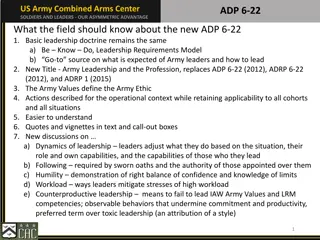Understanding Leadership Theories and Styles
Leadership involves influencing a group towards a common goal. Traits, interaction styles, and group dynamics play vital roles in effective leadership. Various theories, such as Trait Theories and Synthetic Leadership Theories, provide insights into different aspects of leadership. Understanding leadership errors and recovery strategies is crucial. Explore famous leadership styles like the authoritarian style to enhance leadership skills.
Uploaded on Dec 05, 2024 | 0 Views
Download Presentation

Please find below an Image/Link to download the presentation.
The content on the website is provided AS IS for your information and personal use only. It may not be sold, licensed, or shared on other websites without obtaining consent from the author. Download presentation by click this link. If you encounter any issues during the download, it is possible that the publisher has removed the file from their server.
E N D
Presentation Transcript
Leadership Olena Lutsenko, Ph.D., Associate Professor of Applies Psychology Department of V.N. Karazin Kharkiv National University with aid of Lily Cushenbery, Ph.D., Assistant Professor of Management, Stony Brook University
Learning outcomes To know basic theories of leadership. Be able to describe the famous styles and types of leadership. To understand their benefits and vulnerabilities. To define leadership errors and their peculiarities. To understand the ways to recover from these errors. 2
Definition Leadership is a process whereby an individual influences a group of individuals to achieve a common goal. P. Northouse
Trait Theories (E. Bogardus et al.) Congenital set of characteristics (charisma): Intelligence; Dominance; Sociability; Confidence; Initiative; A sense of humor; Enthusiasm and others ... about 80! 4
Theories of interaction style (A. Yago, etc.) Leadership is a process of interaction between the leader and the followers: Depends on the way the leader interacts with the followers; May be a learning result; Accessible to anyone; Depends on the situation. 5
Leadership as a function of the group (G. Homans et al.) A leader is understood as a person who, to a greater extent, than all other members of the group, meets its expectations and most consistently adheres to the norms and values adopted in it - "The Retinue plays the King". Contradiction: "Idiosyncratic credit" - trust, which has a leader from the group on deviation from the norms accepted in it.
Synthetic Leadership Theories Theories that take into account the personality traits, the style of interaction, the peculiarities of the social group and situation - F. Fiedler, B. D. Parigin, etc.: emotional leader, business, moral leaders, leader- motivator, leader-organizer, universal, situational, etc.
The styles of leadership by K. Lewin - an authoritarian style Formal side Content side Business, short orders; Prohibitions without exception, with threats; Clear language, unfriendly tone; Praise and punishment are subjective; Emotions are not taken into account; Examples display is not a system; The position of the leader is above the group. Tasks are planned in advance in full; Only the immediate goals are defined, the future ones are unknown; The leader s word is decisive.
Leadership styles by K. Lewin - democratic style Formal side Content side Instructions in the form of proposals; Friendly tone; Praise and punishment with tips; Orders and prohibitions - with discussions; Leader position - inside the group. Group activities are planned not in advance, but in the group; All members are responsible for the implementation of the proposals; All parts of the work are not only offered but also discussed.
Leadership styles by K. Lewin laissez-faire style Formal side Content side Tone - conventional; Lack of praise or punishment; No cooperation; The leader's position is not visible, "from the side of the group." Affairs in the group go by themselves; The leader does not give directions; The tasks of the work go from the individual interests of the group members or go from the new leader.
Consequences of using different styles Authoritarian: "+" More work is done; high speed "-" Low motivation, less originality, less group cohesion, lack of collective thinking, greater aggressiveness, anxiety, conformism, dependent and submissive behavior. Laissez-faire: "+" More game, more autonomy; "-" The scope of work is lower, the lower quality of work, the goals are often not achieved. Democratic: "+" High quality of decisions, high motivation, less load on the leader; "-" The complexity of ensuring the conditions for effective work, the process of work and decision-making is slower.
Transformational Leadership A process of engaging with others to create a connection that increases motivation and morality in both the leader and the follower. Burns (1978)
Core elements of TL: A concern with emotions, values, ethics, standards, and long-term goals. Includes assessing followers motives, satisfying their needs, and treating them as full human beings.
Transactional Leadership Focuses on the exchanges that occur between leaders and their followers Burns (1978)
No new taxes = votes Sell more cars = bonus Turn in assignments = grade Surpass goals = promotion
While transformational leadership focuses on change within an organization, the goal of transactional leadership is generally to maintain consistency by reinforcing existing rules. Vera & Crossan (2004)
Negative Effects of Transformational Leadership Burnout: Getting subordinates to do more than expected is not always such a great thing Can be seen as manipulative and serving of those higher up in the organization
Transformational and transactional leadership does not always contradict each other. They can be complementary levels of leadership.
Leader Mistakes: How they happen and what you can do about them
What is a leader error? An avoidable action or inaction is chosen by a leader which results in an initial outcome outside of the leader s original intent, goal, or prediction Hunter, S. T., Tate, B. W., Dzieweczynski, J., & Cushenbery, L. (2010).
Famous leaders errors Stalin s ignoring of warnings and unpreparedness before Hitler's attack, 1941 Unpreparedness USA for attack on Pearl Harbor, 1941 USA invasion in the Bay of Pigs, Cuba, 1961 The Three-mile island, the largest nuclear accident in the United States, 1978 Soviet invasion of Afghanistan, 1979 Challenger catastrophe, 1986
How are mistakes unique for leaders? A leader s role is complex thus errors are more likely Hunter, S. T., Tate, B. W., Dzieweczynski, J., & Cushenbery, L. (2010)
How are mistakes unique for leaders? A leader s role is public thus errors are more visible Van Dyck, Frese, Baer, & Sonnentag (2005)
How are mistakes unique for leaders? A leader s role is influential thus errors are more harmful Davidhizar & Laurent (2000)
Error Recovery Strategies High APOLOGIZE Leader Accountability JUSTIFY EXCUSE DENY Low Tata (2000)
Apology Take responsibility for the mistake and show regret. I m so sorry for what I did. APOLOGIZE APOLOGIZE JUSTIFY EXCUSE DENY Tata (2000)
Justification Attempting to make error seem legitimate under the circumstances. I know that hurt you but I think you ll see that I did it for your own good (and I would do it again). APOLOGIZE JUSTIFY EXCUSE DENY Schoenback, 1990
Excuse/Blame An explanation that includes a mitigating circumstance I made that mistake because I was under a lot of time pressure and I had to make a decision quickly. APOLOGIZE JUSTIFY EXCUSE DENY Schoen, 1990; 2000 Tata (2000)
Denial No response or an outright refusal to admit wrongdoing. Did you see the nice weather today? or I didn t do anything wrong. What are those people trying to get out of attacking me? APOLOGIZE JUSTIFY EXCUSE DENY Eubanks et al. 2010; Ferrin, Cooper, Kim, & Dirks, 2007
Vulnerabilities of the strategies Excessive apologies show that the leader is incompetent.
Vulnerabilities of the strategies Excessive excuses show that the leader does not affect the situation.
Vulnerabilities of the strategies Abuse of deny shows that the leader does not deserve trust (dishonest).
How to choose a recovery strategy? You can choose combinations or look for a strategy that is more optimal in this context. Studies show that honesty is more important because it can not be restored, and competence can be restored. Mistakes can be used as means of learning and if demonstrate this to people, it can turn them into your resources.
Positive errors Sometimes mistakes lead to unexpected positive results. Such positive outcomes include training, increased resilience, creativity, and the emergence of innovation (van Dyck, Frese, Baer, & Sonnentag, 2005; Sitkin, 1996; Dormann & Frese, 1994).
Activity group discussion The purpose of the task is the transfer of knowledge. Remember the Presidents of Ukraine or other countries and determine their leadership traits / leadership styles. Can you note any their errors? 5-10 min for self-replies. 10-15 min for discussion.
Get ready to deal with them. Mistakes are a part of leadership.
Structure of the Soft Skills Course Reflective thinking and writing Self- Critical thinking management Presentation skills Academic debate Group work Peer-to-peer Interaction Leadership
Theme Assessment Scores # Forms of learning Maximum mark 32 5 15 8 20 20 Minimum mark 0 0 0 0 0 0 1 2 3 4 5 6 Work during contact hours Presentation Essays, PDP, Learning Log Academic debate Reflective essay (final) Answers to 2 questions in writing (final) Total 100 0
Thank you for your attention and activity!























